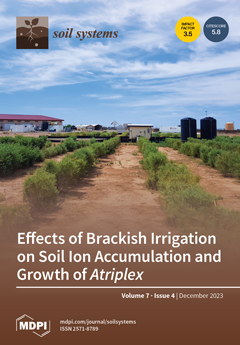Enhanced efficiency fertilizers, such as urea treated with a urease inhibitor, controlled-release fertilizers (CRFs), and fertilizer blends, compose important strategies for improving efficiency in nitrogen (N) use by plants and mitigating ammonia (N-NH
3) emissions. The physical mixture of fertilizers in blends
[...] Read more.
Enhanced efficiency fertilizers, such as urea treated with a urease inhibitor, controlled-release fertilizers (CRFs), and fertilizer blends, compose important strategies for improving efficiency in nitrogen (N) use by plants and mitigating ammonia (N-NH
3) emissions. The physical mixture of fertilizers in blends can favor synchronization of N-release from the fertilizers and N-uptake by coffee plants and also dilute the costs of acquiring a pure CRF, making fertilizer blends more accessible to growers. To investigate this, a field experiment was conducted over two consecutive crop years with
Coffea arabica with the aim of evaluating nitrogen fertilizer technologies at application rates ranging from 0 to 450 kg N ha
−1. The fertilizers were characterized, and analyses were performed to quantify N-release from the fertilizers, ammonia volatilization, and nutritional and yield aspects of the coffee plant. The fertilizers used were urea (UCon), urea treated with N-(n-butyl) thiophosphoric-triamide (UNBPT), urea-coated with polymer of the E-Max technology (with 41%N (EMax41) or 43%N (EMax43)), and blends of UNBPT with E-Max (Blend41–Blend43). The cumulative N-release for EMax41 always remained below that for EMax43, just as occurred for Blend41 in relation to Blend43. Over the two crop years, the greatest volatilization of N-NH
3 occurred with UCon (~25%) and the least with EMax41 (9%). The results indicate that the technologies mitigated the N-NH
3 emissions in relation to UCon [EMax41 (63% mitigation) > Blend41 (43%) > EMax43 (32%) > UNBPT (28%) > Blend43 (19%)]. Crop management affects coffee yield. The yield increase went from 20% in the first crop year to 75% in the second, with better results from fertilizers containing CRF. We present information that can assist fertilizer producers and coffee growers, and, above all, we seek to contribute to environmental action for the reduction of agricultural NH
3, clarifying potential strategies for mitigation of these emissions and strategies that generate advances in research on technologies for coffee growing.
Full article





